Introduction: Gena Philibert-Ortega is a genealogist and author of the book “From the Family Kitchen.” In this blog article, Gena searches old newspapers to learn about a part of World War II that many people don’t know: there were hundreds of thousands of prisoners of war (POWs) that were kept in the U.S. during the war.
When I was growing up, I – like many youthful book lovers – read the novel Summer of My German Soldier by Bette Green. This fictionalized account dealt with a relationship between an American Jewish girl and an escaped German prisoner from a Prisoner of War (POW) camp in the United States during World War II. This little-remembered history was explored in that book and later the accompanying TV adaptation.
Like many works of fiction, Summer of My German Soldier was loosely based on historical events. During World War II, the United States was home to approximately 400,000 Prisoners of War. Roughly 379,000 were German military personnel. These prisoners were housed in 900 camps scattered throughout the U.S.*
POWs Working and Living in America
For many people, the idea of POW camps on American soil may seem bizarre. This is a part of World War II history not often discussed in high school history classes. During the war, the Allies captured POWs and had to house them somewhere. In many places in the U.S., these prisoners became a part of everyday American life – actually working on individual family farms as well as for larger employers. We associate the idea of prisoners with being locked up and hidden from a community – but not so with the POWs who spent time in the United States during and shortly after WWII. With American men off fighting the war, American women and these POWs helped make up the labor force needed on the home front.
What types of agricultural work did prisoners do? This brief 1946 newspaper article provides one example, reporting on 3,121 German POWs who were assigned to sugar beet thinning in southern Idaho.
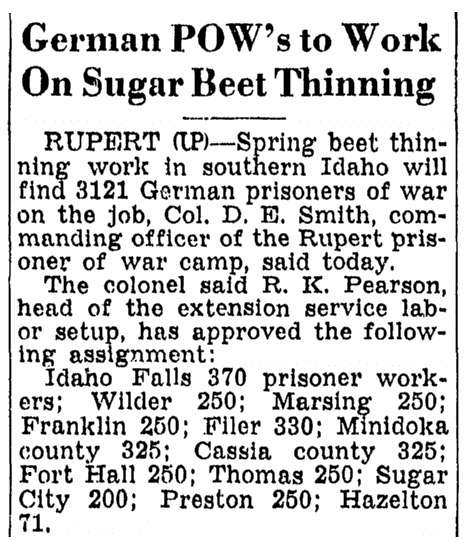
POWs assisted with the shortage of laborers by working on all types of farms. This 1944 article explains that German POWs were brought into Lepanto, Arkansas, by the War Food Administration’s Bureau Office of Labor to pick cotton.
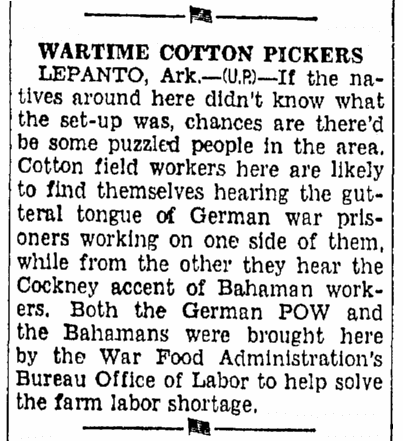
American Resentment for Treatment of German POWs
With the recent release of the movie Unbroken and other similar accounts, we have a better understanding of how our POWs were mistreated at the hands of the Axis powers. So how were enemy soldiers treated in the United States? Prisoners of War housed in America were treated according to the rules of the Geneva Convention. Housing, food and work conditions for POWs were equal to that for our own U.S. soldiers. While this angered some citizens, the Joint Chiefs had hoped that this treatment would be reciprocated for our own POWs held by Germans.** Many Americans considered this fair treatment too good for enemy soldiers. There was much opposition to the perceived “cushy” life that POWs lived in the U.S.
[search_box]
In this letter to the newspaper editor from PFC Robert J. Kuhn, a U.S. soldier and former POW captured in Africa and held in “Italian and German concentration camps,” Kuhn voices his dismay at the preferential treatment of German POWs and their interaction with American women. In his letter, sent from “somewhere in Italy,” he recounts reading in the military newspaper Stars and Stripes about German POWs living in the United States:
…and then I read: “American soldier gets letter from girlfriend now engaged to German soldier – POW from camp in America” – couldn’t believe it. Then I saw in another one: “German prisoners in America have sit-down strike for day.” Also “POW go on excursions in America.” “POW in America have morale dance.”
Did American prisoners of war have German frauleins? Did we go to dances? Did we go on excursions? And above all, did we sit down and strike? No! No! No!
He continues on by mentioning, approvingly, that French women who cavorted with German soldiers had their heads shaved as punishment. His sentiments are understandable, and one can easily see how outrageous it was to American soldiers to find out that enemy soldiers were interacting with American families – and, in some cases, dating American women during their imprisonment!
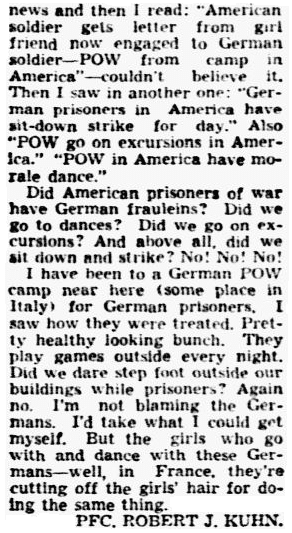
Some German POWs Escaped
Over 2,000 German POWs tried to escape while being held in the United States. Most POW escapees were caught fairly quickly – but there were a few who eluded capture for months, years, and in at least one case, decades. Many German POW who escaped didn’t get too far before they were caught or voluntarily surrendered.
This 1946 newspaper article tells of the escape of Helmut von der Au (in some articles his name is spelled von Der Aue) from Camp Breckenridge, Kentucky. At the time of the writing of this newspaper article, von der Au had already escaped twice before. He had an advantage over other German POWs who tried to escape from camps in the United States because he could speak English. He had a plan for what he would do in a successful escape: “He would steal a P-38 (Lightning) fighter plane and fly to Greenland.” A lawyer prior to the war, von der Au was apprehended three days after his latest escape when he surrendered to police in Uniontown, Kentucky, less than 10 miles from where he began. He walked up to Police Chief Gilbert Page, still in his prisoner uniform, and asked to be returned to camp because he was hungry.
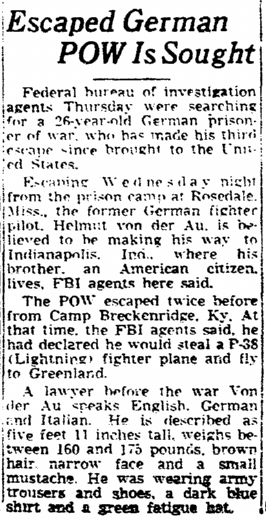
Helmut von der Au’s story doesn’t end there. He eventually is sent to Mississippi where he is one of many prisoners who helps out on a plantation. Over time he becomes well acquainted with the plantation owner’s wife and the two fall in love. Running off together seemed like a good idea at the time, but the couple is eventually caught and his American lover, Mrs. Edith Rogers, was held for aiding in the escape of an enemy of the United States.
According to this 1946 newspaper article, the “…27-year-old, dashing German officer met Mrs. Rogers, 37-year-old Mississippi society woman, as a member of a war prisoner labor detail assigned to the 1000-acre Bolivar county plantation of her husband, Joseph R. Rogers. He and Mrs. Rogers became such close friends, von Der Aue explained to federal authorities…that after a number of drinks they decided to leave and be married.”
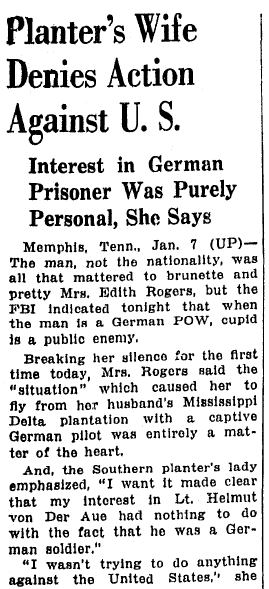
Edith Rogers wasn’t the only American woman to fall in love with a German POW. Joan McBride, with the help of her husband James McBride, assisted Rudolph Joseph Soelch, a former bodyguard for Hermann Goering, escape from the camp he was being held at in Southern California. For six months Soelch lived as “Mr. McBride” and worked in Detroit alongside Joan. Joan’s husband left her when she proclaimed her love for the German POW. Eventually they were apprehended and Soelch was repatriated back to Germany and told never to enter the United States again.
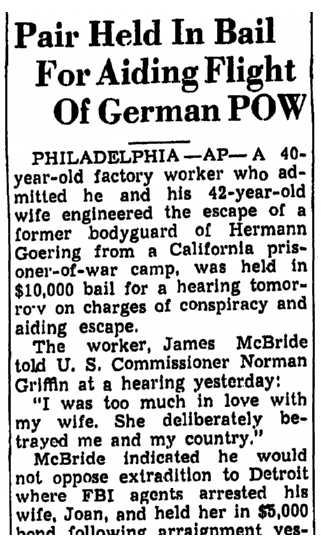
Repatriation of POWS after the End of WWII
World War II came to a close with Japan’s surrender on 2 September 1945. Now the work of repatriation of all POWs living in the United States would begin.
[search_box]
January 1946 newspapers announced that former Axis soldiers would be sent back to their home countries in four months. (In reality it took longer.) The newspaper article below explains that later that month Japanese POWs would be sent out of the U.S. mainland but would not go directly home. Some would be sent to Hawaii for assignments. The historical news article ends by asserting that some POWs did not want to go home. Understandably, due to high unemployment and conditions in their homeland, some German POWs wanted to stay in the United States.
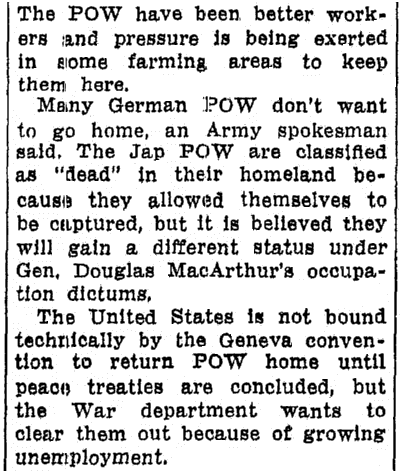
While there were German POWs who eventually returned to the United States to live permanently, there were undoubtedly some cases where they wanted to return as soon as possible – like in the case described in this 1946 newspaper article, where a young POW stowed away on a ship so that he could return to the United States because “he liked it so much.”
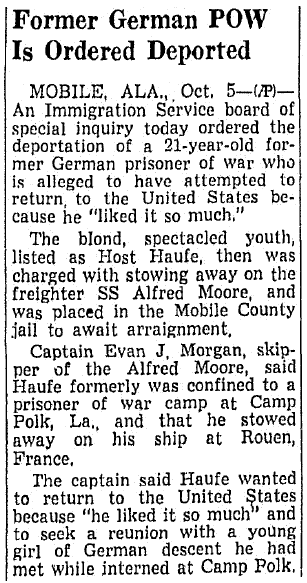
World War II History and Family History
As family historians, we seek to learn more about our family’s lives. As you research your military family and ancestors, don’t forget about those on the home front. I’ve had family members tell me stories of living near POW camps and the experiences they had living in close proximity and interacting with the “enemy.” Now’s the time to seek out these remembrances, or to record your own.
To learn more about World War II history on the American home front, check out GenealogyBank’s Historical Newspaper Archives.
In addition to the news reports and first-hand accounts that can be found in old newspapers, several books have been written about POW camps in the United States. They include:
- Buck, Anita. Behind Barbed Wire: German Prisoners of War Camps in Minnesota. St. Cloud, Minn: North Star Press of St. Cloud, 1998.
- Fiedler, David. The Enemy among Us: POWs in Missouri during World War II. St. Louis: Missouri Historical Society Press, 2003.
- Krammer, Arnold. Nazi Prisoners of War in America. Chelsea, MI: Scarborough House, 1996.
- Marsh, Melissa A. Nebraska POW Camps: A History of World War II Prisoners in the Heartland. Charleston: The History Press, 2014.
Did you or any of your family members have any contact with POWs held in America during WWII? Please tell us your stories in the comments section.
———————
* HistoryNet. German POWs: Enemies In Our Midst. http://www.historynet.com/german-pows-enemies-in-our-midst.htm. Accessed 17 February 2015. This resource includes a map with POW camp locations.
** HistoryNet. German POWs: Coming Soon to a Town Near You. http://www.historynet.com/german-pows-coming-soon-to-a-town-near-you.htm. Accessed 17 February 2015.
[bottom_post_ad]

This was the case where I live. In fact a whole quarterly publication was written about it, and is available free online:
http://www.libraryweb.org/~rochhist/v56_1994/v56i3.pdf
Larry,
Thanks so much for posting the link and sharing that resource.
Gena
In 1971 I was stationed at Beale Air Force Base near Marysville, California and saw some of the remaining cells that Nazi SS prisoners were held when Beale was an Army base.
There were also WW I German POW s held at Fort Oglethorpe, Georgia a few moles south of Chattanooga, TN. There are many listed in the 1920 Catoosa County, GA Federal Census.
Evan. I was assigned to Beale AFB in 1972. It is interesting that very little is known about the German POWs. There was an escape from the POW compound at Beale. They dug a tunnel that came up under the South-East corner Guard Tower. Several Germans escaped only to be caught within days. Their plan was to go to Mexico then to Germany. One made it halfway then found a policeman and turned himself in. Also the local farmers used them to pick peach’s. He found that if they were given a bottle of beer at the end of the day before they returned to Camp Beale, they would work harder the next day.
Evan, above, mentions Camp Beale… my boyfriend’s grandfather was a guard there during WW2; a long way from his home in New England. When he joined the military he did training in Florida, and then was stationed in CA. My bf’s father remembers that family road trip very vaguely, as he was young.
He better remembers the time they spent in the came, and the prisoners – he has noted that it was his definite impression that the POWs were not hardened Nazis by any means, but German citizens drafted and forced into service who had little ill will toward Americans; they loved the US and some formed relationships with the guards over time. The family also still has about a dozen beautifully painted wooden coats-of-arms (about 15″h x 12″w) that the Germans made in the prison wood shop – crafts were encouraged to keep them occupied. It was impractical for them to take them home when they were repatriated, so they gave them to the guards. They hang in the den along with pictures from that time period, including one of my boyfriend’s father as a child in a German costume that the prisoners had handmade for him.
I’ve found it very difficult to find any military-based sources of info on these POW camps online – newspaper reports (as you’ve found) are much more revealing. Likewise, my boyfriend’s grandfather’s military record is quite straightforward; it lists only rank and dates and locations, no details of his exact service; he is gone and there are only my boyfriend’s father’s recollections from his childhood now.
Fascinating topic; thanks for sharing this!
Miscelena,
Thanks so much for sharing this information. Newspapers do provide an important glimpse into this history and are easily accessible online. Other resources for records (including US military records) could be found through the National Archives.
Thank you for taking time to comment. I really appreciate it.
Gena
Evan,
Thanks for providing that information. I’ll be checking out that census enumeration.
Gena
My wife and I grew up in Ohio. When we cleaned out her Aunt’s house on her passing, we found an oil painting signed “Richard Schreck” and on the back was labeled “Richard Schreck German POW Camp Perry Ohio 1944”. We would love to learn more about this, but google searching has not provided much.
Dick,
What a great find! There’s a few places you could search for Richard Schreck. NARA would hold the records for the POWs at Camp Perry. You could contact the National Archives at Chicago (they hold records for Ohio) and inquire whether they have the records or if they are archived in Washington, D.C.
You may also want to contact the Friends of Camp Perry (http://friendsofcampperry.org/index.html) and ask if they have any records of the POWs housed there. They may have a museum or library that may be of use.
I would also inquire at local libraries (public and academic) and museums to see if they have any information that may be of help.
Good luck!
Gena
I interviewed several people in Georgia who remembered the German prisoners working on their family farms. I also wrote and co-produced a film based on a true event that happened in Middle Georgia. The film is My Christmas Soldier. It is on DVD or probably even on Youtube. These stories are fascinating and I enjoyed researching this topic. So much history that is invisible around us. All we have to do is talk to people and look around.
Muriel, thanks for sharing information about the film you wrote. I found it on the IMDb database, http://www.imdb.com/title/tt0826768/ . That must have been a fascinating project to work on.
And I agree with you. There is so much history around us but sometimes we need to ask the questions that start those conversations.
Thanks for taking the time to comment. –Gena
My grandmother spoke of POW German soldiers coming to the farm to help my grandfather in the fields. They lived in Iroquois County just a few miles from the village of Woodworth, Illinois. At that time there was a German Lutheran school that my mother and her brothers and sisters attended speaking only the German language. My grandmother and grandpa were German and they had a very large family. They had a big table in the kitchen for the soldiers coming to eat breakfast and lunch that my grandmother prepared for them, and she cooked straight German food. They always talked about how they loved her cooking and how it made them homesick for Germany. There was much conversation between my grandfather and the POWs. My mother recalled one time her little sister came into the kitchen and one of the soldiers started crying and he said that she look just like his daughter at home in Germany.
Kathy,
Thanks for sharing that. It makes me wonder if your grandparents faced any discrimination in their town because they were German.
I hope you’ve written their stories down for your family to remember.
Thank you for sharing them here.–Gena
My Father was in charge of POWs during WWll in Fraser and Winter Park, Colorado. The prisoners were taught how to cut trees for the railroads and for telephone poles. I have letters from England where some were shipped after the war and from Germany when they were finally sent home. Why can I not find any history about Winter Park and Fraser, Colo., and these prisoners?
Sherry,
It looks like there is information about the camp on the Fraser, Colorado website as well as photos. A Google search on “Fraser Colorado POW camp” turned up some results on the web as well as in Google Books.
Local museums and university archives would be another place to contact for histories. It’s possible a local university student may have completed a thesis on the topic so a Colorado university library might be helpful in that regard. The Denver Public Library has a local history collection that you may want to take a look at.
The National Archives has records of these camps as well so you could contact the National Archives office at Denver. Also, browsing newspapers for that time period will provide various articles on the camps that might be useful to you.
Good luck in your research–Gena
What I’ve noticed is the missing POW Camps. One located in Seabrook, New Jersey, that housed Japanese, and the one in Fairton, New Jersey. The latter being part of our family homestead, and farm. These weren’t internment camps, these were prisons and there were a lot of things going on in those woods. The First Defense Airbase in the U.S. was located 6 miles northeast in Millville, N.J. From what is in family documents it’s been stated that we were never allowed to plow that field that was 100 acres in the middle of the woods, and I recall finding all kinds of war relics there. The adjacent 300,000 acres was used for artillery and a gunnery bombing range, used by tanks until the 70s. Warren Grove Range is still active, located in the Pine Barrens between McGuire Fort Dix Lakehurst NAES about 7 miles inland of Long Beach Island.
Sonny, Thanks for sharing this. I appreciate it. –Gena
Thank you so much for all this information, along with the newspaper cuttings. I’m researching for a book I am writing, and I wonder if anyone could help me. Does anyone know if German POWs, arrested in Paris after the liberation in August 1944, might have been sent to the USA?
Thank you.
Is there a list available of German POWs? Any directions where to look?? Thank you.
Christina, you might want to send an email to the National Archives. I looked in a few books I had and online and it appears those records are part of Record Group 389 (https://www.archives.gov/research/guide-fed-records/groups/389.html).
Recently I received my father’s German military records. He was a POW in Camp Rucker, Fort Jackson, Camp Forest, and Camp Opelika, for more than 20 months (1944-1946). I have started to collect information to map out his journey. Camp 23 seems to be the only stop that is a mystery to me at this point. You expressed interest in families that have had contact with German POWs in your article. I have several postcards from a woman in North Carolina, who seems to be instrumental in my family’s immigration. I have found her obituary, and am still looking for living family members that might have information. Any further suggestions to help me in my search would be helpful. Thanks.
Corinna, you might want to try social media websites to help with your search for living family members. Have you tried searching for the family surname on Facebook?
If it’s a small town, you might want to contact the local genealogy or historical society and see if anyone knows the family.
Good luck with your search! –Gena
Gena Philibert-Ortega: There is an interesting article on German POWs in Utah. The Utah prisoner of war massacre (headlined by Time as “Midnight Massacre”) took place after the end of World War II in Europe at midnight on July 8, 1945, at a German and Italian prisoner-of-war camp in Salina, Utah. Nine German prisoners of war were murdered and nineteen prisoners were wounded by American private Clarence V. Bertucci, who was on active duty in the camp. After a night out, Bertucci returned to camp around midnight to assume his night duty at the guard tower. Bertucci subsequently loaded the .30-caliber M1917 Browning machine gun on the tower and fired at the tents of the sleeping prisoners. After the massacre, he revealed his motivation was that “he had hated Germans, so he had killed Germans.” Six Germans were immediately killed, three died in Salina’s hospital, and nineteen were wounded.
The victims were buried with full military honors at the Fort Douglas Cemetery. Wounded prisoners were sent back to Germany after they were healthy enough to travel. After the massacre, Bertucci was taken into custody with little resistance. He was evaluated for a few weeks, before doctors determined that he was “mentally unbalanced.” Military officers forwent a court-martial on account of insanity and he was sent to Mason General Hospital in New York for an undisclosed amount of time. The Midnight Massacre is remembered for being “the worst massacre at a POW camp in U.S. history” and represented the largest killing of enemy prisoners in the United States during World War II. A museum was opened at Camp Salina in 2016. If you can find the movie “Splinters of a Nation” it will give more details about this. It was done for PBS Utah. I was an extra doing a Doctor impression.
Randall, thank you so much for this information. I’ll definitely look into that movie.
When I was six years old, my parents and I lived at Camp Hale in the Colorado Rockies. My dad was a civilian working for the Peter Kiewit Construction company. I began first grade there in a barracks with three grades in each room. The POWs were helping to tear parts of the camp down. They also delivered ice (we had ice boxes) and picked up the trash, guarded by soldiers with rifles. They always said, “Wie Geht’s” [How’s it going] when they saw me in the yard in my swing.
Camp Hale held “about 400 of the most incorrigible members of Field Marshal Erwin Rommel’s Afrika Korps.” The Korps was the German expeditionary force in Africa during the North African campaign of World War II. First sent as a holding force to shore up the Italian defense of its African colonies, the formation fought on in Africa, under various appellations, from March 1941 until its surrender in May 1943. (Colorado History). The prisoners made beautiful crafts, and my family still has a couple of objects, as well as a like-new army blanket. I think there was only one escape (two prisoners) with the help of a Nazi-sympathizing American. They made it to the Mexican border where all were arrested. Any escapees quickly returned to their prison due to the cold weather and the wild animals. Not a friendly environment.
I am currently writing a memoir of my then-six-year-old self living at Camp Hale for six months. Lots of interesting memories. I found this site looking for more information on German POWs.
Wow, Judith! What an experience. Thank you for sharing it.
Good luck with your book. –Gena
I enjoyed reading this article. During 1943-1945 there were 200,000 German POWS housed here in Texas. Several hundred were located at White Rock Lake in East Dallas, Texas. From what I have heard, some of the Germans POWs helped out with farmers getting their farms up and running. After the war ended, some of the Germans remained here in Texas and moved to East Texas to live and raise a family. Got involved with the community and church activity.
Thanks for providing that information Mary. I appreciate it..–Gena